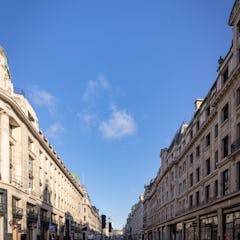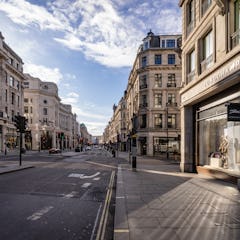History
Regent Street is the world’s first shopping street and was designed by architect John Nash, who also designed the Buckingham Palace, together with James Burton. It was designed and built during the Regency era of British history and was part of a grand urban planning project initiated by the Prince Regent, who later became King George IV. The project aimed to reshape and modernise the area to the north of Pall Mall and St. James’s Park, which was becoming overcrowded and run-down.
Architecture
The Prince Regent appointed the architect John Nash to design Regent Street and the surrounding areas. Nash’s vision was to create a grand, sweeping boulevard featuring elegant, neoclassical buildings and showcasing Georgian architecture. The street was laid out in a curve, following the land’s natural contours, and it extended from Piccadilly Circus in the south to Regent’s Park in the north. It was one of the first purpose-built shopping streets in the world. Construction of Regent Street began in 1811, and the street was opened in 1819.
Regent Street quickly became a fashionable and popular shopping destination for London’s elite. It was lined with high-end boutiques, department stores, and other retail establishments, making it a hub of luxury and commerce.
Today
Regent Street remains a major shopping and cultural hub in London. It is known for its distinctive architecture, including the use of Portland stone, and its prominent shopping areas like Regent Street St. James’s and Regent Street Quadrant.
You can find numerous shops on Regent Street, most of which are clothing stores. There are many chain stores, for example, Zara, Mango and Guess. Designer shops on the street include Calvin Klein, Mulberry and Boss. Over the years, Regent Street has been home to many iconic establishments. One of the most famous is Hamleys, the world-famous toy store founded in 1760, which moved to Regent Street in the 1880s. The nearby Liberty department store, celebrated for its distinctive Tudor-revival architecture and a curated selection of luxury goods, further elevates the street’s retail allure. Other landmarks include the Café Royal, a historic hotel and restaurant, and the Quadrant Arcade, an ornate shopping arcade.
The street has been converted to be more pedestrian-friendly in recent years with added trees and plants. Going to see the Christmas light displays is an important part of every Christmas in London for many, with its beautiful Spirit of Christmas angels shining light on the street.
Regent Street’s rich history, architectural significance, and continued role as a vibrant retail and cultural destination make it an important part of London’s heritage. It remains a must-visit location for tourists and shoppers alike.













